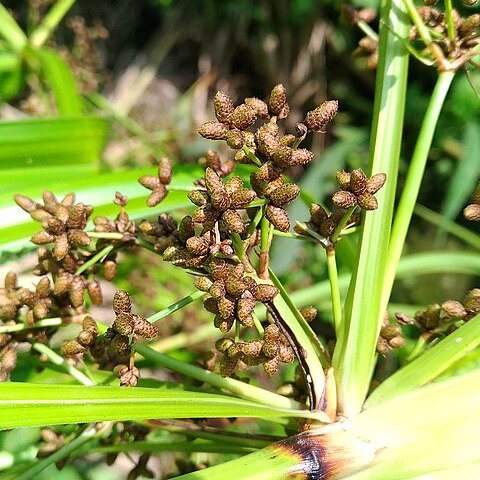Perennial. Stems erect, rather stout to stout, trigonous, triquetrous just below the inflorescence, leafy, smooth, several-noded, 50-200 cm by 4-8 mm. Leaves rigid, flat, gradually acuminate, the cauline ones often overtopping the stem, ¾-2½ cm wide; margins scaberulous; ligule a membranous rim, or absent in the upper leaves; lower sheaths shining fuscous to castaneous. Inflorescence terminal, um-belliform, copiously branched, compound to supra-decompound, usually dense, 10-25 cm across. Involucral bracts 3-5, leaf-like, overtopping the inflorescence, the lowest up to 50 cm. Primary rays several, divaricate, very unequal, smooth, up to 10 cm. Spikelets in clusters of 4-10, ovoid to oblong-ovoid, terete, obtuse, rarely acutish, very densely many-flowered, brown, 2½-6 by 2-3 mm. Glumes membranous, tightly appressed, hardly keeled, ovate to almost orbicular, obtuse, submucronulate, 1-nerved, 1¼-2½ 1-1½ mm. Bristles 0-3(-6), delicate, sparsely antrorsely scaberulous in the upper half. Stamens 2-3; anthers oblong-linear, 3/5-1 mm. Style glabrous; stigmas 2, rarely in some flowers 3. Nut plano-convex or unequally biconvex, strongly dorsiventrally compressed, obovate, mi-nutely apiculate, smooth, pale brown, ¾-1 by ½-¾ mm.
More
Culms 60-100 cm tall, stout, 3-angled, several nodose. Leaves longer than culm; basal sheaths blackish purple, shiny; leaf blade 1-1.5 cm wide, flat, stiff, leathery, margin slightly scabrous. Involucral bracts 5 or 6, leaflike, basal 3 or 4 overtopping inflorescence. Inflorescence a large compound or decompound anthela, 7-10 × 8-15 cm; rays 5 or more, to 9 cm, stout, spreading, smooth. Spikelets sessile, in headlike clusters of 4-10, ovoid, ellipsoid, or oblong, 3-8 × 2.5-3.5 mm, many flowered, apex obtuse. Glumes brown, densely arranged, broadly ovate to ovate-orbicular, ca. 1.2 mm, membranous, with 1 pale brown vein, apex obtuse to rounded. Perianth bristles 2 or 3, longer than nutlet, erect, apical half sparsely antrorsely scabrous. Style filiform, 1.2-1.5 mm; stigmas ?2. Nutlet pale yellow, ellipsoid, obovoid, or subspherical, 0.7-1 mm, biconvex. Fl. and fr. (May-)Jun-Aug.
A sedge. These grow in clumps and have grass like leaves and solid stalks.
In open wet places, in thickets and forests, on banks of streams, often in large clumps, chiefly between 800 and 2000 m; in New Guinea up to 2650 m, but also collected at 30 m (PULLE 152).

